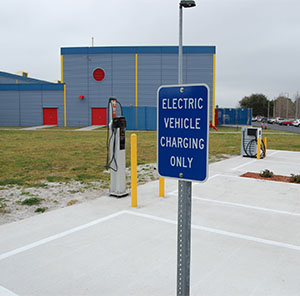Carlos Colon and The Florida Solar Energy Center Takes Center Stage (Part II)

Electric Vehicle Charging Station at FSEC
March 2, 2015
Continuation of this series’ part one about Carlos Colon’s patent-pending, energy-saving water heater improvement
Solar cells shine with iridescence in the sunlight through the building’s full-window front, and technologies on display are paired with explanations of their science and promise. I’m expecting to sit with Mr. Colon at a desk or conference table to hear about the center and his research, but we set out on a tour to see what’s happening up close.
He points through the glass wall of the atrium to concrete slabs in a grassy area, explaining, “The original purpose of the center was to test solar collectors to heat water. That’s how FSEC got started. And then the brilliant minds working there said, ‘Well, there’s more to energy than just solar collectors.’ So they started getting into photovoltaic, fuels, and hydrogen. Then we started getting into energy efficiency, buildings—residential buildings, commercial buildings—and transportation. And so today we have a lot of different areas that we research, and it’s all energy related, of course.”
On sunny days, on-site solar collectors moved to the grassy area track the sun across the sky. The data they collect on-site and remotely is used to establish standards for solar technology efficiency and durability, data that’s one part of a massive transmission from FSEC’s mainframe of servers to institutions across the country.
Colon introduces our next stop, the high bay laboratory, saying “Most of the chemistry, hydrogen, and thin film semiconductor research is done in those laboratories. Here, we are investigating thin film 3D printing, hydrogen research, and testing with evacuated chambers,” as he points to the machine that simulates space conditions for various experiments. “It’s exciting; none of this was here before, compared to where we started at Cape Canaveral.”
The center has grown since its move to the current Cocoa facility in 1995, and I ask how often it expands. “It depends,” he says, “mostly on government funding, a little bit of private industry, and when somebody invents something that’s useful for some private company.”
A fenced yard spanning the space behind the two main buildings houses a grove of mockup roofs to test the solar array and water heating systems you might see on your neighbors’ houses. Here, solar technology is rated and certified to ensure consumers get high-quality products when investing in solar arrays to produce energy and water heating systems designed to conserve energy.
In an industrial-style building beside the mockups, solar cells can be tested under controlled conditions by using a solar simulator machine the size of a small living room. Beyond it, a garage door waits for the next electric car model to pass through, brought in for testing with equipment that measures how much energy the car expends on the road and how much energy is left.
“One of our current contracts is with the department of transportation because of the research into electric cars, and we’ve built a charging station right in front of our Cocoa building.”
Making our way back to the main building of FSEC, it occurs to me that I’d driven by this building many times and not known anything about its contributions. Mid-thought, I stop and ask my tour guide about a pushpin-dotted map spotted through a barely open office door.
It’s a map of schools across the state with solar arrays on site, he explains. “It’s a project we’ve been working on for a while,” I hear from K-12 educational specialist Penny Hall, the office occupant who’s joined the conversation. “Those are all ten-kilowatt systems with data monitoring for the kids so they can see what the system’s doing.”
The pushpin colors note the different years each array has been put in place. With every year comes a crop of students fired up about what FSEC and other research efforts can accomplish, more voices of support, and, someday, more consumers and citizens who know new technology won’t magically appear without research and a way to make that research happen.
And that’s a sunny thought.
>>Written by Lisa Bottomley